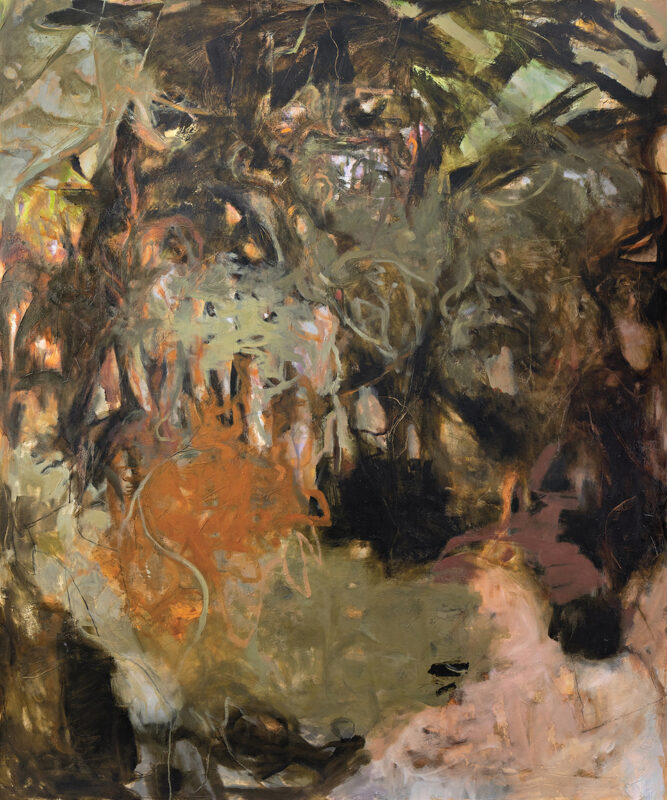
Ellsworth Courthouse Gallery presents “Linda Packard: I Dreamt I Was The Moon,” a solo exhibition highlighting a selection of large-scale abstract paintings that Packard created for a solo show at the Zillman Art Museum in Bangor. The Zillman show ran from January through May 2024, before traveling to Courthouse Gallery this past August.
In conjunction with the exhibitions, Courthouse Gallery produced a video of an artist talk by Linda Packard held at the Zillman Art Museum, and as a catalog. The video and the catalog can be viewed at courthousegallery.com/artist/linda-packard.
Zillman director and curator George Kinghorn wrote an introduction for the catalog and Chris Crosman wrote the essay. Crosman is the former as director of the Farnsworth Art Museum in Rockland, Maine, and the founding chief curator of Crystal Bridges Museum of American Art in Bentonville, Arkansas.
Before offering Packard the exhibition, Kinghorn followed the development of her work with great enthusiasm for over ten years. Her work “evolved to embody the best qualities of non-objective paintings — primarily a sophisticated palette and rich mark-making,” said Kinghorn. The Zillman Art Museum acquired In Silence, I Do Not Count the Time, 2023, a six-by-five-foot oil and charcoal on canvas, for museum’s permanent collection.
In his essay “Shadows in the Mirror: Recent Paintings by Linda Packard,” Crosman talks about abstract art in Maine, Packard’s roots as a plein landscape painter, and “the under-known history of women and abstraction” He includes Packard in “a tradition of painterly postwar women artists, beginning most notably with Helen Frankenthaler’s 1952 masterpiece, Mountains and Sea, and continuing with work by Joan Mitchell, Grace Hartigan, Gretna Campbell, and Lynne Drexler (the latter three having longstanding Maine ties).” Crosman notes Packard’s challenges “The six-foot paintings, whether square, vertical, or horizontal in orientation, come from a tight studio unable to accommodate anything much larger than her slight frame and the canvases she is working on.” He discusses Packard’s process at length, her use of “tough” colors, and her preference for muted tertiaries and earth tones. “Her ‘almost blacks’ are especially complex with personal blends of viridian, alizarin, and ultramarine. … this almost green-black punctuates the surface, like shutters on an isolated Maine farm house glimpsed through trees and blowing snow.”
Cosman concludes his essay by saying Packard could have given “Rembrandt a run for the mysteries of underpainting and dissolving, indeterminate spatial relationships. There is more than a hint of Baroque exuberance and spiritual intimacy, of sonorous color and fluttering drapery; Rubens and Rembrandt vigorously arguing and conversing in the underpainting. Occasionally, she will allow pops of brighter color or larger, light- and mist-laden passages to emerge from within the darker, denser earth-toned recesses of her muted palette. Individual brushstrokes become small and large exhalations rising from yellow-ochre or gray-green interiors built of countless and varied touches. These paintings and those moments are the hours of learning what paint can and cannot do, embracing painting’s past with new ways of looking at deeply personal expressions of sudden, uncontainable, and not so accidental beauty.”
Linda Packard (b.1952) is an abstract painter whose work remains strongly informed by her many years as a plein air landscape painter. She continues to be drawn to the same organic shapes, textures, and earthy palette. Packard finds excitement in the physicality of oil paint and the way it behaves with a wide variety of mark-making tools and different surfaces. She earned a BA in Studio Art from Smith College with a concentration in drawing and printmaking. She continued to study at the Boston Etching Studio and at the Kaji Aso Studio/Gallery, Boston, as well as typography and book arts at Northeastern University. From 2009 to 2013, Packard studied with Jon Imber, the late master painter of Boston, and Stonington, Maine. Packard still cites Imber as her greatest influence. In 2015, she was awarded a Heliker-LaHotan Residency Fellowship on Great Cranberry Island, Maine, and in 2017, she was a Weir Farm Artist-in-Residence in Wilton, Connecticut. In 2024, the University of Maine Zillman Art Museum in Bangor, highlighted a selection of Packard’s large-scale abstract paintings in a solo show. Packard, who grew up Ashburnham, Massachusetts, moved to coastal Maine in 1985, and now lives in Bangor where she maintains a year-round studio. Her paintings are included in corporate and private collections throughout the United States.
Courthouse Gallery is at 6 Court St., Ellsworth. For gallery hours or more information, call 667-6611 or visit www.courthousegallery.com.
Categories: Ellsworth, exhibitions, gallery, shows
Tags: art

